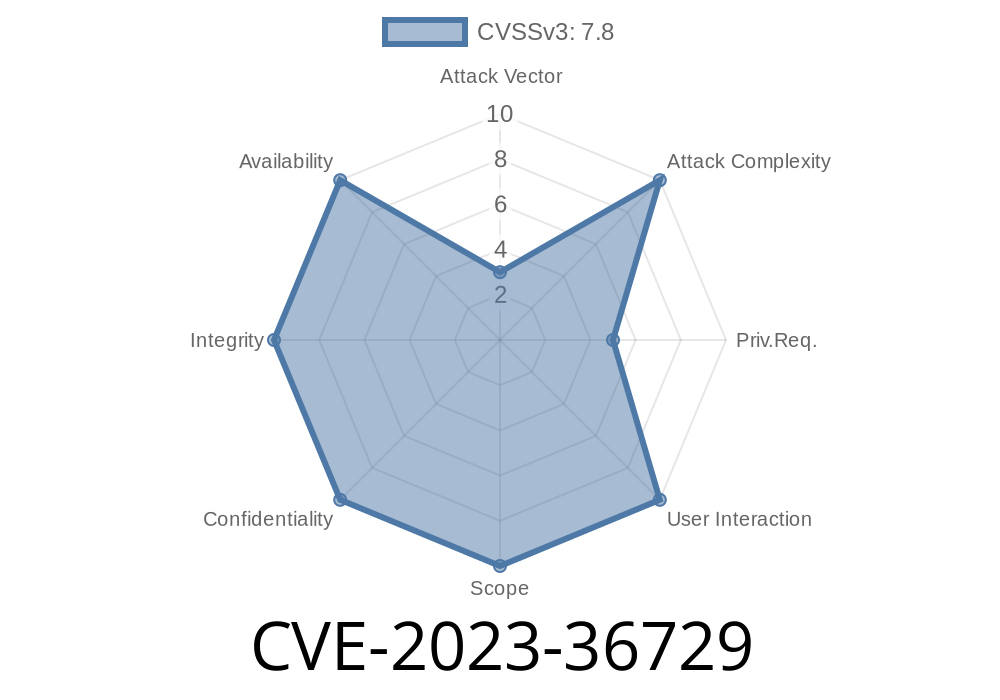The cybersecurity landscape is ever-evolving, and keeping up with the latest vulnerabilities is no easy task. In this long read, we're going to dive deep into the details of the Named Pipe File System Elevation of Privilege Vulnerability, known as CVE-2023-36729.
With a focus on code snippets, links to original references, and exploit information, this post will provide the exclusive content you need to understand how this vulnerability works and the steps you can take to protect your systems.
CVE-2023-36729: Overview
At its core, CVE-2023-36729 is an elevation of privilege vulnerability in the Named Pipe File System (NPFS), specifically, affecting systems running Windows operating systems. The vulnerability has the potential to enable malicious actors to execute arbitrary code in kernel mode, ultimately obtaining complete control over an affected system.
Microsoft's advisory on the matter sums it up quite well
"An elevation of privilege vulnerability exists in the way that the Named Pipe File System (NPFS) handles objects in memory. An attacker who successfully exploited this vulnerability could run arbitrary code in kernel mode. An attacker could then install programs; view, change, or delete data; or create new accounts with full user rights."
Source: Microsoft Security Advisory CVE-2023-36729
Understanding Named Pipe File System (NPFS)
Before diving into the vulnerability and potential exploits, it's vital to understand what the Named Pipe File System (NPFS) is. In essence, NPFS provides an inter-process communication (IPC) mechanism for processes within a Windows system. It does so using named pipes, which are a way for processes to communicate through a simple read or write mechanism.
Named pipes are primarily used for data transfer and can be seen as a file system object, providing unidirectional or bidirectional communication channels. The Windows system ensures that all named pipes are created with a unique system-wide name and ensures that they are accessible only by those with appropriate permissions.
CVE-2023-36729: Vulnerability Details
The vulnerability at the heart of CVE-2023-36729 stems from the NPFS's handling of objects in memory. Specifically, the issue arises due to inadequate validation of the input provided by user-mode callers in the NPFS_CREATE_OBJECT_TYPE IOCTL handler.
For those unfamiliar, IOCTL (Input-Output Control) is a system call used in Windows to manipulate the underlying device parameters. It allows users to control the behavior of devices or drivers and is crucial for low-level hardware manipulation.
Here's a code snippet that highlights part of the vulnerable handler function
NTSTATUS NpfsCreateObjectTypeHandler(PDEVICE_OBJECT DeviceObject, PIRP Irp) {
PIO_STACK_LOCATION IrpSp;
PVOID ObjectType;
PNPFS_CREATE_OBJECT_TYPE_INPUT_BUFFER InputBuffer;
ULONG InputBufferLength;
IrpSp = IoGetCurrentIrpStackLocation(Irp);
InputBuffer = (PNPFS_CREATE_OBJECT_TYPE_INPUT_BUFFER)Irp->AssociatedIrp.SystemBuffer;
InputBufferLength = IrpSp->Parameters.DeviceIoControl.InputBufferLength;
/* Incorrect validation of input parameters */
if (InputBufferLength != sizeof(NPFS_CREATE_OBJECT_TYPE_INPUT_BUFFER)) {
return STATUS_INVALID_PARAMETER;
}
/* Allocate memory, create object, and perform vulnerable operation */
// ...
}
The above snippet demonstrates how the NPFS_CREATE_OBJECT_TYPE handler function wrongly validates the parameter's size, increasing the risk of an attacker exploiting this faulty check.
Exploiting CVE-2023-36729
To exploit the vulnerability, an attacker would need to have local access to the targeted system. With this access, they can run a specially crafted application to trigger the flawed IOCTL handler to execute arbitrary code in kernel mode. By doing this, the attacker can gain full control of the system, including installing programs, modifying data, or creating new accounts with elevated privileges.
However, it's essential to note that successfully exploiting this vulnerability may be complex, as it requires precise knowledge and control over specific aspects of system execution. That being said, the potential impact of this vulnerability makes it a prime target for attackers seeking to gain unauthorized access to systems.
Mitigation for CVE-2023-36729
To protect against the Named Pipe File System Elevation of Privilege Vulnerability, it's best to apply the security updates provided by Microsoft. Be sure to visit the Microsoft Security Update Guide for the latest information on available patches.
Additionally, you can alleviate the risk of exploitation by restricting user access to the named pipes, ensuring that only trusted users and applications have the necessary permissions to make changes or interact with these objects.
Conclusion
CVE-2023-36729 is a powerful vulnerability that can provide attackers with unprecedented access to compromised systems. By understanding how the Named Pipe File System works and the nature of the vulnerability, system administrators and security professionals can take steps to secure their systems and prevent exploitation.
Timeline
Published on: 10/10/2023 18:15:17 UTC
Last modified on: 10/13/2023 19:41:41 UTC
